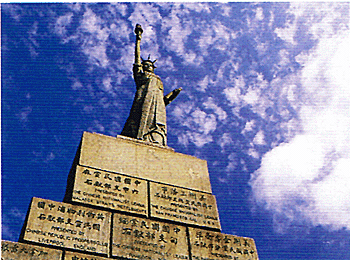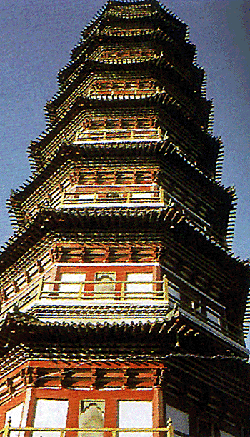|
Guangdong is the origin of the modern Chinese revolution and cradle of China's modern civilisation. It's
most outstanding period in China's long history has occurred over the past one and a half centuries.
 In the 19th century, the Qing government of China was weak and corrupt, and the country was on the
brink of collapse. Guangdong, the trading port of China, had become the springboard for the invasions by Western powers. The burning of opium at Humen in 1839, and the Humen Battle and Sanyuanli
Anti-British Struggle during the Opium War, were epic pages in Guangdong's history. In the 19th century, the Qing government of China was weak and corrupt, and the country was on the
brink of collapse. Guangdong, the trading port of China, had become the springboard for the invasions by Western powers. The burning of opium at Humen in 1839, and the Humen Battle and Sanyuanli
Anti-British Struggle during the Opium War, were epic pages in Guangdong's history.
The special environment of culture and humanity made Guangdong a location where
thoughts of reform could originate in modern China. Great men appeared one after another here: Hong Xiuquan, the leader of Taiping Heavenly Kingdom Uprising; Kang Youwei
and Liang Qichao, famous reformers of the late Qing Dynasty; and Dr. Sun Yat-sen. The
1911 Revolution led by Dr. Sun Yat-sen overthrew the feudal monarchy and established the new republic. The 72 Martyrs Mausoleum at Huanghuagang in Guangzhou stands as the symbol of the 1911
Revolution.
 In the 1920s, Guangdong became a political theatre of the Chinese Revolution. There are many well-preserved historical sites: the
Huangpu Military Academy set up during the first cooperation
between the Kuomintang and the Communists; the Peasant Movement Institute directed by Mao Zedong; the ruins
of the headquarters of the Northern Expedition;
the site of the Guangzhou Commune and the
Honghuagang Martyrs' Cemetery of the 1927 Guangzhou
Uprising. In the 1920s, Guangdong became a political theatre of the Chinese Revolution. There are many well-preserved historical sites: the
Huangpu Military Academy set up during the first cooperation
between the Kuomintang and the Communists; the Peasant Movement Institute directed by Mao Zedong; the ruins
of the headquarters of the Northern Expedition;
the site of the Guangzhou Commune and the
Honghuagang Martyrs' Cemetery of the 1927 Guangzhou
Uprising.
Besides its role in contemporary Chinese history, Guangdong was also an important
part of the illustrious ancient Chinese civilisations. As early as in the 9th century B.C. during
the Zhou Dynasty, people in this area, together with residents at the middle reaches of the
Yangtse River, founded the Chu Court. The region became a part of the unified China in later
dynasties, known as the Nanhai (South Sea) Province in the Qin Dynasty (221-207 B.C.) and
the Nanyue (Southern Yue) State in the Western Han Dynasty (206 B.C.-A.D. 24)
During
the Tang Dynasty (618-907) it became an important trading harbour between the Central
Plains of China and Arabian and Western countries. Guangzhou served as China's only foreign trade port before the Qing Dynasty 1644-1911

|
Canton Travel (Guangzhou):
Attrative Coastal Views,
A Front Runner In Economi Growth,
A Histori Plae In Modern China,
A Paradise For Shoppers,
Eating And Shopping,
Foreword,
Great Entertainment,
Kaleidoscope Reform Opening Up,
Leading The Trend In Tourism,
Life Along The Coastal Countryside,
Major Festivals,
Picturesque Mountains And Waters,
Ports Leading To The Outside World,
Profile Guangdong,
The Golden Tourist Routes
|
Main Cities in China Travel and China Hotels







 Beijing Beijing  Canton Canton
 Shanghai Shanghai  Hong
Kong Hong
Kong  Qingdao Qingdao  Hangzhou Hangzhou |
Other Major Cities:
Changchun,
Chengdu,
Chongqing,
Dalian,
Dongguan,
Dunhuang,
Foshan,
Guangzhou,
Guilin,
Haikou,
Harbin,
Hainan,
Hangzhou,
Kunming,
Lhasa,
Macau,
Nanjing,
Qingdao,
Sanya,
Shenyang,
Suzhou
Shanghai,
Shenzhen,
Tianjin,
Weihai,
Wenzhou,
Xiamen,
Xi'an,
Yiwu
|
Major China Hotels:
Beijing Hotels,
Chengdu Hotels,
Chongqing Hotels,
Dalian Hotels,
Foshan Hotels,
GuangZhou Hotels,
Guilin Hotels,
Hangzhou Hotels,
Harbin Hotels,
HongKong Hotels,
Kunming Hotels,
Macau Hotels,
Nanjing Hotels,
Qingdao Hotels,
Sanya Hotels,
Shanghai Hotels,
Shenyang Hotels,
Suzhou Hotels,
Tianjin Hotels,
Urumqi Hotels,
Wenzhou Hotels,
Xiamen Hotels,
Xian Hotels |
|  |
|
 In the 19th century, the Qing government of China was weak and corrupt, and the country was on the
brink of collapse. Guangdong, the trading port of China, had become the springboard for the invasions by Western powers. The burning of opium at Humen in 1839, and the Humen Battle and Sanyuanli
Anti-British Struggle during the Opium War, were epic pages in Guangdong's history.
In the 19th century, the Qing government of China was weak and corrupt, and the country was on the
brink of collapse. Guangdong, the trading port of China, had become the springboard for the invasions by Western powers. The burning of opium at Humen in 1839, and the Humen Battle and Sanyuanli
Anti-British Struggle during the Opium War, were epic pages in Guangdong's history. In the 1920s, Guangdong became a political theatre of the Chinese Revolution. There are many well-preserved historical sites: the
Huangpu Military Academy set up during the first cooperation
between the Kuomintang and the Communists; the Peasant Movement Institute directed by Mao Zedong; the ruins
of the headquarters of the Northern Expedition;
the site of the Guangzhou Commune and the
Honghuagang Martyrs' Cemetery of the 1927 Guangzhou
Uprising.
In the 1920s, Guangdong became a political theatre of the Chinese Revolution. There are many well-preserved historical sites: the
Huangpu Military Academy set up during the first cooperation
between the Kuomintang and the Communists; the Peasant Movement Institute directed by Mao Zedong; the ruins
of the headquarters of the Northern Expedition;
the site of the Guangzhou Commune and the
Honghuagang Martyrs' Cemetery of the 1927 Guangzhou
Uprising.





